Our team aims at rationalizing and accelerating the discovery of innovative bioactive molecules. It stands at the interface of many disciplines (informatics, medicinal chemistry, structural biology, pharmacology) and therefore attracts students from quite diverse areas of expertise. We do perform virtual screening and medicinal chemistry optimization in-house along three main research areas

Virtual Screening
Our team has has played a pioneering role in promoting virtual screening in Europe (Bissantz et al. 2000) and keeps on developing and applying in silico screening methods.
1. Databases
2. Methodological developments
- ChemoGen: virtual screening in cgemogenomics space with in-house devloped kernels (see more)
- Grim: description of protein-ligand interaction patterns by graphs (see more), recently ranked 2nd/43 for predicting binding poses in the D3R Grand Challenge 2015 (see more)
- Profiler: off-target prediction method, using a mix of ligand-based (2D and 3D similarity search, pharmacophore search) and structure-based docking approaches (see more)
- RLPharm: automated method to define protein-ligand based pharmacophores, developed in collaboration with BIOVIA (see more). Has led to a unique collection of > 140K pharmacophores for studying either off-target activity or for drug repurposing (see more)
- VolSite: automated detection of protein cavities and druggability estimate (see more)
3. Recent in silico screening applications
We have undertaken 14 in silico screen campaigns over the last 5 years, mostly with the objective to identify the very first ligands of novel targets of high pharmacological value.
| Target | Method | Query | Screened | Tested | Hits | Reference | |
|---|---|---|---|---|---|---|---|
| TrkB | Docking | Inhibitors | 78045 | 22 | 2 | @10 µM | Cazorla et al. 2011 |
| TrkB | Pharma | PAMb | 8 061 | 45 | 2 | @10 µM | Not published |
| OXYR | FPLPc | Antagonists | 336678 | 120 | 10 | @10 µM | Weill et al., 2011 |
| GLR | Docking | NAMd | 7378 | 22 | 3 | @10 µM | de Graaf et al., 2011 |
| PrPsc | Docking | Inhibitors | 350000 | 32 | 1 | @20 µM | Ayrolles-Torro et al., 2011 |
| Stat3 | Docking | Inhibitors | 78119 | 9 | 1 | @50 µM | Pudlo et al., 2015 |
| SmNACE | Docking | Inhibitors | 61166 | 98 | 20 | @100 µM | Jacques et al., 2015 |
| FLT3 | Docking + Pharm | Extracellular Inhibitors | 343847 | 60 | 6 | @100 µM | WO 2016016370 A1 |
| Lingo-1 | Docking | PPIe | 174327 | 145 | 3 | @20 µM | Not published |
| Integrin α5β1 | Docking + Pharm | NAM | 6247 | 67 | 3 | @50 µM | Not published |
| CD38 | Docking + Pharm | Inhibitors | 254713 | 177 | 67 | @100 µM | Not published |
| Mfd | Docking | Inhibitors | 95 | 4 | @50 µM | Not published | |
| Smoothened | Docking + Pharm | NAM | 1300000 | 67 | 6 | @5 µM | Not published |
Altogether, we have identified 42 hits which were fully confirmed experimentally and led to medicinal chemistry hit to lead optimization programs (TrKB, Stat3, SmNACE, CD38, FLT3, intéine a5b1, Mfd, Smoothened). Among the most interesting hits, we have notably found:
- the very first nanomolar extracellular inhibitor of the TrkB tyrosine kinase receptor (ANA-12) with potent in vivo antidepressant and anxiolytic properties;
- the first TrkB positive allosteric modulator (TB001), inducing a TrkB specific neurite growth with potential applications in neurodegenerative diseases;
- the first extracellular inhibitor of the FLT3 tyrosine kinase receptor (BDT001) with potent anti-hyperalgesic properties in rodent models of neuropathic pain;
- inhibitors of the Smoothened oncogene, targeting the homodimeric form of the receptor, with potent anti-tumoral activities
- inhibitors of the Mfd virulence factor, with antibacterial properties in multi drug resistant infections.
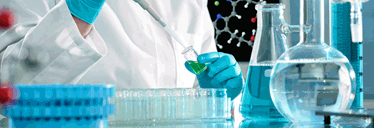
Medicinal Chemistry Optimization of In Silico Hits
Pharmacodynamic and pharmacokinetic properties of our in silico hits are optimized in-house by our medicinal chemistry group. Here are 3 examples:
1.TrkB extracellular inhibitors
Trkb is the tyrosine kinase receptor for BDNF (Brain derived neurotrophic factor), a potent neurotrophin essential for neuronal growth. Our Trkb extracellular inhibitor (ANA-12) is potent (IC50 = 4.3 nM), selective (vs. Trka1 and TrkC) and exhibits potent antidepressant and anxiolytic properties in rodents when administered i.p. at the dose of 0.5 mg/kg. Within the framework of an ANR grant (TrkBDNFarmod: ANR 11-BSV4-017-02, we have synthesized 57 analogs by varying the heteroaromatic ring A, the three amide bonds, the core aromatic ring B and the lactame C.
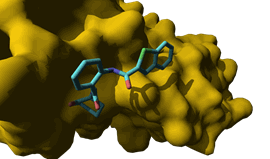
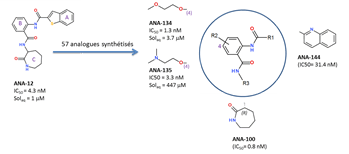
Observed structure-activity relationships indicate that:
- a position (position 4) of the B ring that is tolerant to the substitution with solubilizing moieties without altering in vitro potency;
- 2 out of the 3 amide bonds cannot be altered;
- ring A is very susceptible to chemical variations;
- the binding of ANA-12 to TrkB is stereoselective: (R)-isomer being 1000 times more potent than the (S)-isomer;
- a good permeation of the blood-brain barrier for some analogs (e.g. ANA-135)
Collaborations:
- M. Cazorla (Grenoble Institute of Neurosciences, Grenoble, France)
- L. Lanfumey (Psychiatry and Neurosciences Center, Paris)
- M. Hamon (Psychiatry and Neurosciences Center, Paris)
2.FLT3 extracellular inhibitors
FLT3 is the receptor tyrosine kinase for the FL cytokine. Beyond its well established role in promoting cell differentiation in hematopoietic cells, we have discovered the unique property of FLT3 to behave as a main hub for triggering chronic pain upon nerve injury. Within the framework of a maturation program (INSERM-Transfert, SATT AxLR-Montpellier), one in silico hit (compound 11) previously identified to prevent the extracellular binding of the FL cytokine to its FLT3 tyrosine kinase receptor has been optimized by medicinal chemistry.
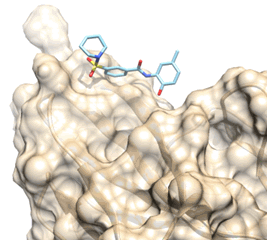
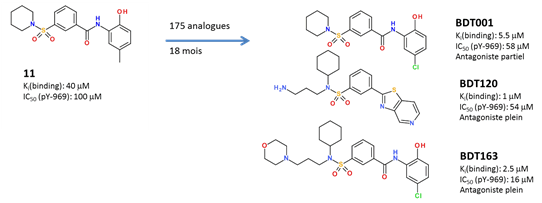
- enhanced in vitro potency (x40);
- switch from partial to total functional antagonism
- enhanced aqueous solubility(x400);
- selectivity for off-targets
- enhances metabolic stability
Optimized analogues (e.g. BDT001, BDT120, BDT169) exhibit strong anti-hyperalgesic properties in rodent models (CCI, SNL, SNI) of neuropathic pain, at low doses (2.5-5 mg/kg i.p.). The chemical series is protected by a patent (WO 2016016370 A1) and led to a start-up company (BIODOL Therapeutics, Montpellier), aiming at developing these compounds in clinical trials, for the treatment of chronic neuropathic pain.
Collaborations:
- J. Valmier (Institute of Neurosciences, Montpellier, France)
3.CD38 inhibitors
CD38 is a cell surface receptor acting as activation biomarker of immune cells. It is implicated in numerous cell signaling mechanisms among which survival of heart cells. Within the framework of a collaboration with SERVIER Laboratories, we have synthesized 59 analogs of our initial in silico hit (ICD4) and discovered potent human CD38 inhibitors (IC50 = 900 nM). The most promising compounds are currently evaluated for their effects on cardiomyoctes. We separately optimized another CD38 inhibitor selective for the Schistosoma mansoni receptor (see more)
Collaborations:
- A. Wagner, H. Steffner-Muller (UMR7199, Illkirch, France)

Unravelling molecular mechanisms of actions
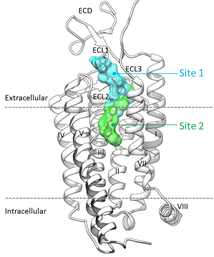
Our established expertise in molecular modelling, notably on G protein-coupled Receptors (GPCRs), led us to propose binding modes for many GPCR ligands which are validated by site-directed mutagenesis and in vitro binding/functional assays among which:
- S1P1 receptor agonists ( Van Loenen et al., Eur. J. Pharmacol., 2011)
- Mu opiate antagonists ( De Wachter et al., J. Med. Chem., 2011);
- Fluorescent analogs of muscarininic M1 and M2 receptors (Daval et al., J. Med. Chem., 2012; Daval et al., Mol. Pharmacol., 2013), of the vasopressin V2 receptor Loison et al., J. Med. Chem., 2012), and of the dopamine D3 receptor (Hounsou et al., ACS Chem. Biol, 2015)
- Antagonists of the non classical GPCR Smoothened ( Ruat et al., Trends Pharm. Sci., 2014; (Hoch et al., FASEB J.., 2015)
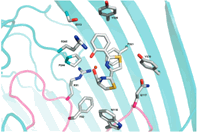
We have also been implied in deciphering the binding mode of siderophores (iron-chelating ligands) by the FptA transporter of Pseudomonas aeruginosa ( Brillet et al., J. Am. Chem. Soc., 2011; Noel et al., Org. Biomol. Chem., 2011; Noel et al., Bioorg. Med. Chem. Lett. J.., 2014)
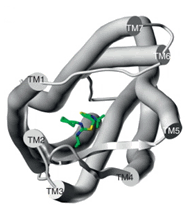
In a long collaboration with the Pasteur Institute (B. Lagane, Dpt. of Virology), we have explained the the binding mode of the antiviral drug Maraviroc® to the chemokine CCR5 receptor antagonist; its allosteric nature ( Garcia-Perez et al., J. Biol. Chem., 2011; Garcia-Perez et al., J. Biol. Chem., 2011). We also have determined the influence of the V3 loop of the viral gp120 protein on the Maraviroc-induced resistance to VIH infection ( Garcia-Perez et al., Retrovirol., 2015 ).
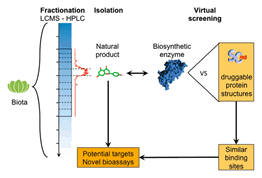
We collaborate with Prof. R. Quinn (Griffith University, Brisbane, Autralia) to explain the cross-reactivity of natural products by biosynthetic enzymes and drug targets, thereby explaining why these compounds are a rich source of potential drug-candidates ( Kellenberger et al., Nat. Prod., 2011; Sturm et al., J. Chem. Info. Model., 2012; Sturm et al., Planta Med., 2015).
Collaborations
- A.E. Alewijnse (Academic Medical Center, Amsterdam,The Netherlands.)
- D. Tourwé (Vrije Universiteit, Brussels, Belgium)
- J.L. Galzi, I. Schalk (UMR 7242 CNRS, Ecole Supérieure de Biotechnologie de Strasbourg, Université de Strasbourg)
- T. Durroux, B. Mouillac, G. Guillon, J.P. Pin (Institut de Gémique Fonctionnelle , Montpellier, France)
- M. Ruat (Alfred Fessard Institute of Neurobiology,Gif Sur Yvette, France)
- B. Lagane, F. Arenzana-Seisdedos (Pasteur Institute, Paris)
- R. Quinn (Eskitis Institute for Drug Discovery, Griffith University, Brisbane, Australia.)
